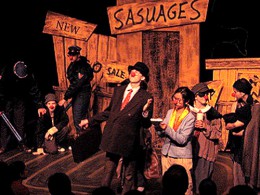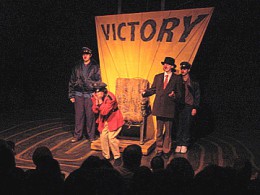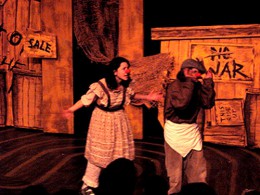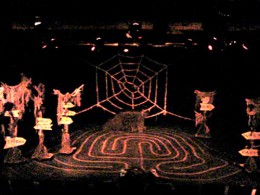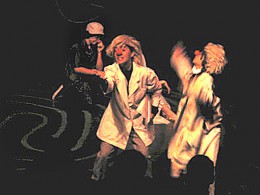A commedia of love, politics, and magic. The long war is over, King Tartaglia is victorious, but his kingdom is in shambles. Twins who had been abandoned as infants venture out to seek their fortune and find themselves in a wild journey through a labyrinth of love.
Written by Conrad Bishop & Elizabeth Fuller based on the play by Carlo Gozzi
Directed & designed by Conrad Bishop, music by Elizabeth Fuller
Costumes by Liz Smith
Lighting by Wayne Hovey
Two acts; 7m/10w; multiple sets.
Produced by Cinnabar Young Rep, premiering April 6, 2007, at Cinnabar Theatre (Petaluma, CA). 6 performances.
From a note to a friend:
Last year Cinnabar asked me to direct The Hobbit for their “Young Rep†series (10-17-year-olds). Though we’d done work with high schools before, I wasn’t quite prepared for discovering the level of talent and energy there. It was a wild ride, and a lovefest. Invited back, I wanted to do something that really pushed the kids to their comic limits. We’d adapted another Gozzi commedia (The King Stag) years ago, and The Green Bird attracted us for the same reasons: its theatricality & emotional resonance, its mix of metaphor & clowning, and in a strange way it seemed a logical sequel to Elizabeth’s dark solo clown piece Dream House, which we’re now touring.
Why adapt? Gozzi is one of those writers whose very creativity lures you into meddling with every bit of him. To me, the landmark Gozzi stagings by Andrei Serban and Julie Taymor are incredibly beautiful but too exotic and distanced, and the original text itself much too rhetorical for my taste. So we’ve adhered pretty much to the plot but rewritten the text entirely, reversed Gozzi’s anti-Enlightenment conservatism but allowed him in as a character to defend himself. For a “family†audience, the bawdry of the original wouldn’t fly, but we’d have altered that anyway: this piece is much more about the politics of love than the hormones.
From a note to the costume designer:
You may be familiar with The Green Bird, as it’s been done at Berkeley Rep and also at SSU. This, however, is much different—keeping the basic characters and the plot, but the scenes are completely rewritten. Unlike the Julie Taymor staging, I don’t want to go toward the exotic oriental kind of thing. It’s very contemporary, and I want to find contemporary “clown†personae in the style of Chaplin or vaudeville zanies like Ed Wynn, i.e. present-day clothing but mismatched or outsized or with a few archaic elements. We might in fact use red noses, maybe even lighten the complexions, but otherwise no “clown†makeup. Then there are some exotic characters in the enchanted forest, and the title character that will probably go somewhat outside that style.
This summer I did a two-week intensive with the kids at Cinnabar, working on character and exaggerating into the clown dimension. I found that the real breakthru came when I brought in a bunch of hats and let them start improvising with them. Whereas I’d worked my ass off in The Hobbit to get the Dwarfs to have any individuality, suddenly these kids were doing amazing things, spurred by the spirit of their hats. So what I’d like to do, to whatever degree is possible with the logistics, is to “evolve†the costumes along with the characters during the course of rehearsals. Obviously that presents problems, and we have to balance it with reality, but to whatever extent it’s possible it’ll make a real difference.
I enjoyed doing The Hobbit even though it wasn’t a story I was earnestly dying to tell. This piece is different: much more difficult, but I think with the potential of absolutely killing the audience with laughter and magic.
—Conrad Bishop
